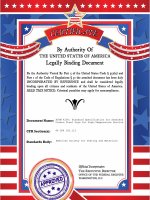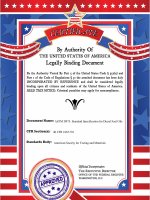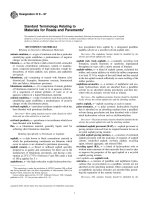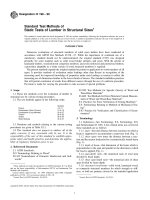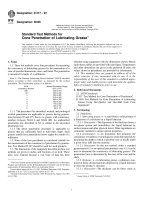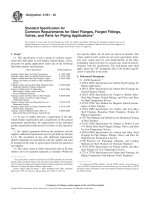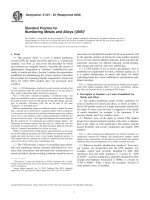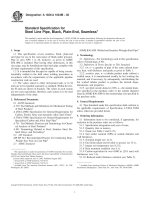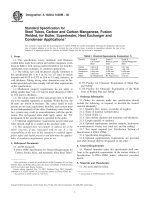Tiêu chuẩn ASTM A 1014 : Standard Specification for Precipitation-Hardening Bolting Material (UNS N07718) for High Temperature Service
Bạn đang xem bản rút gọn của tài liệu. Xem và tải ngay bản đầy đủ của tài liệu tại đây (22.99 KB, 5 trang )
This document is not an ASTM standard and is intended only to provide the user of an ASTM standard an indication of what changes have been made to the previous version. Because
it may not be technically possible to adequately depict all changes accurately, ASTM recommends that users consult prior editions as appropriate. In all cases only the current version
of the standard as published by ASTM is to be considered the official document.
Designation: A 1014 – 023
Standard Specification for
Precipitation-Hardening Bolting Material (UNS N07718) for
High Temperature Service1
This standard is issued under the fixed designation A 1014; the number immediately following the designation indicates the year of
original adoption or, in the case of revision, the year of last revision. A number in parentheses indicates the year of last reapproval. A
superscript epsilon (e) indicates an editorial change since the last revision or reapproval.
1. Scope*
1.1 This specification covers a precipitation hardening bolting material (UNS N07718) for high temperature service.
1
This specification is under the jurisdiction of ASTM Committee A01 on Steel, Stainless Steel and Related Alloys and is the direct responsibility of Subcommittee A01.22
on Steel Forgings and Wrought Fittings for Piping Applications and Bolting Materials for Piping and Special Purpose Applications.
Current edition approved March 10, 2002. Oct. 1, 2003. Published June 2002. November 2003. Originally published as A 1014 – 00. approved in 2000. Last previous
edition approved in 2002 as A 1014 – 002.
*A Summary of Changes section appears at the end of this standard.
Copyright © ASTM International, 100 Barr Harbor Drive, PO Box C700, West Conshohocken, PA 19428-2959, United States.
1
A 1014 – 023
2. Referenced Documents
2.1 ASTM Standards: 2
A 370 Test Methods and Definitions for Mechanical Testing of Steel Products
A 962/A 962M Specification for Common Requirements for Steel Fasteners or Fastener Materials, or Both, Intended for Use
at Any Temperature from Cryogenic to the Creep Range
B 637 Specification for Precipitation-Hardening Nickel Alloy Bars, Forgings, and Forging Stock for High-Temperature Service
B 880 Specification for General Requirements for Chemical Check Analysis Limits for Nickel, Nickel Alloys, and Cobalt
Alloys
E 112 Test Methods for Determining the Average Grain Size
E 292 Test Methods for Conducting Time-For-Rupture Notch Tension Tests of Materials
2.2 ANSI Standards:
B1.1 Screw Threads3
2.3 SAE Standards:
AS 7467 Bolts And Screws, Nickel Alloy, UNS N07718 Tensile Strength 185 KSI Stress Rupture Rated Procurement
Specification4
3. Ordering Information
3.1 Ordering—It shall be the responsibility of the purchaser to specify all requirements that are necessary for product under this
specification including any supplementary ones and those included in the ordering information required by Specification
A 962/A 962M.
4. Common Requirements
4.1 Common Requirements—Product furnished to this specification shall conform to Specification A 962/A 962M, including
any supplementary requirements indicated on the purchase order. Failure to comply with Specification A 962/A 962M constitutes
non-conformance with this specification. If the requirements of this specification conflict with those of Specification
A 962/A 962M, then the requirements of this specification shall prevail.
5. Manufacture
5.1 Melting Process—Alloy shall be multiple melted using consumable electrode practice in the remelt cycle or shall be
induction melted under vacuum. If consumable electrode remelting is not performed in vacuum, electrodes produced by vacuum
induction melting shall be used.
5.2 Heat Treatment:
5.2.1 Solution Treatment—Material shall be solution heat treated at a temperature within the range of 1725 to 1850°F (941 to
1010°C), held at the selected temperature for a time commensurate with cross-sectional thickness, and cooled at a rate equivalent
to an air cool or faster.
5.2.1.1 Temperature Variation—Solution treating temperatures shall be controlled in the range of 6 25°F (6 14°C).
5.2.2 Precipitation Heat Treatment—Material shall be heated to a temperature of 1325°F (718°C), held at temperature for eight
hours minimum, furnace cooled to 1150°F (621°C) at 100°F (56°C) per hour, held at temperature for eight hours, and cooled to
room temperature. Alternatively, material may be furnace cooled to 1150°F (621°C) at any rate provided the time at 1150°F
(621°C) is adjusted so the total precipitation heat treatment time is 18 hours minimum.
5.2.2.1 Temperature Variation—Precipitation treatment temperatures and cooling rates shall be controlled in the range of 6
15°F (6 8°C).
5.3 Straightening—When straightening is necessary it shall be done after solution treating and prior to aging. Straightening after
aging is prohibited.
5.4 Threads—Threads shall be formed by rolling in one pass after oxides have been removed from the area to be threaded.
5.5 Dimensions and Tolerances, Bolting Material—Fully heat treated bolting material shall meet the dimensional requirements
of Specification B 637 for UNS N07718.
6. Chemical Composition
6.1 Remelt Ingots—The chemical analyses of each remelted ingot shall conform to the requirements for chemical composition
prescribed in Table 1.
2
For referenced ASTM standards, visit the ASTM website, www.astm.org, or contact ASTM Customer Service at For Annual Book of ASTM Standards,
Vol 01.03. volume information, refer to the standard’s Document Summary page on the ASTM website.
Annual Book of ASTM
3
Available form American National Standards, Vol 01.01. Institute, 11 W. 42 nd St., 13th Floor, New York, NY 10036.
Annual Book
4
Available from Society of ASTM Standards, Vol 02.04. Automotive Engineers (SAE), 400 Commonwealth Dr., Warrendale, PA 15096-0001.
2
A 1014 – 023
TABLE 1 Chemical Requirements
Element
UNS N07718
(Formerly Grade 718)
Carbon, max.
Manganese, max.
Silicon, max.
Phosphorus, max.
Sulfur, max.
Chromium
Cobalt, max.A
Molybdenum
Columbium +
Tantalum
Titanium
Aluminum
Boron, max.
IronB
Copper, max.
NickelC
0.08
0.35
0.35
0.015
0.015
17.0–21.0
1.0
2.80–3.30
4.75–5.50
...
0.65–1.15
0.20–0.80
0.006
Remainder
0.30
50.0–55.0
A
If determined.
Determined arithmetically by difference.
C
Nickel + Cobalt.
B
6.2 Product Analysis—If a product (check) analysis is performed by the purchaser, the material shall conform to the product
(check) analysis variations prescribed in Specification B 880.
7. Mechanical Properties
7.1 Tensile and Hardness—All testing shall be performed after aging. The test specimens shall meet the requirements of Table
2.
7.2 Stress Rupture—Stress rupture testing shall be conducted in accordance with Table 2 using a combination test bar in
accordance with Test Methods E 292. Rupture must occur in the smooth section of each test specimen.
7.3 Headed Fasteners—In addition to 7.1 and 7.2, headed fasteners with body length three times the diameter or longer shall
be subjected to full size tensile test in accordance with Annex A3 of Test Methods and Definitions A 370 and shall conform to the
tensile strength shown in Table 2. The minimum full size breaking strength (lbf) for individual sizes shall be as follows:
Ts 5 UTS 3 As
(1)
where:
Ts
= tensile strength,
UTS = tensile strength specified in Table 2, and
As
= stress area, square inches, as shown in ANSI B1.1 or calculated as follows:
As 5 0.785 ~D – ~0.974/n! !2
where:
D = nominal thread size, and
n = the number of threads per inch.
TABLE 2 Mechanical Properties
Tensile and Hardness
Tensile strength, min, ksi (Mpa)
Yield Strength, min, ksi, (Mpa) 0.2 % offset
Elongation in 2 in., min %
Reduction of area, min, %
Hardness, Brinell
185 (1275)
150 (1035)
12
15
331–444
Stress Rupture Requirements
Temperature, °F (°C)
Stress, ksi (Mpa)
Hours, min
Elongation in 2 in., or 50 mm (or 4D), min %
1200 (650)
100 (690)
23
5
Elevated Tensile Requirements
Temperature, °F (°C)
Tensile strength, min, ksi (Mpa)
Yield Strength, min, ksi, (Mpa) 0.2 % offset
Elongation in 2 in., min %
Reduction of area, min, %
3
1200 (650)
145 (1000)
125 (860)
12
15
(2)
A 1014 – 023
8. Metallography
8.1 Microstructure—The microstructure shall be free of freckles, white spots, and Laves phases. Threads may show evidence
of cold working as a result of rolling. The average grain size shall be determined in accordance with Test Methods E 112 and found
to be ASTM No 5 or finer. Up to 20 % of the structure may have a grain size as large as a No. 3 due to the presence of
noncrystallized grains.
8.2 Macrostructure—Fasteners produced from forgings shall exhibit continuous flow lines in the threads and in any shank to
head or fillet and/or bearing surface areas.
9. Number of Tests
9.1 Chemistry—One test per remelt ingot.
9.2 Mechanical Properties—The number of tests shall be in accordance with Specification A 962/A 962M except that for stress
rupture one test shall be run per lot. For headed fasteners with a body length less than three times the diameter a separately forged
test bar may be used for tensile and stress rupture testing provided it is heat-treated with the parts. Separately forged bars shall
be approximately the same diameter as the headed fastener they represent.
9.3 Grain Size—One test per lot.
9.4 Flow Lines—One test per lot on forged fasteners after final machining.
9.5 Headed Fasteners—One tensile test per lot.
10. Workmanship
10.1 Bolting Material—Shall be uniform in quality and condition, smooth, commercially straight or flat, and free of injurious
imperfections.
10.2 Fasteners—Multiple laps on thread flanks are prohibited. Seams, laps, notches, slivers, or oxide scale in the root area of
threads are prohibited. Cracks are prohibited.
11. Product Marking
11.1 Marking—Fasteners shall be marked with “718” and the manufacturer’s identification symbol.
12. Certification
12.1 Report—In addition to the requirements of A 962/A 962M, certification shall include the solution treatment cycle time and
temperature and the aging cycle time(s) and temperature(s).
13. Keywords
13.1 bolts; fasteners; Iconel 718; nickel alloy; precipitation hardening; temperature service application – high
SUPPLEMENTARY REQUIREMENTS
These requirements do not apply unless specified in the purchase order and in the Ordering
Information, in which event the specified tests shall be made before shipment of the product.
S1. Fillet Rolling
S1.1 The fillet area of the fastener headProtective Atmosphere
S1.1 Heat treatment shall be rolled. performed under suitable protective atmosphere.
S2. Forged Heads
S2.1 HeadsCleaning
S2.1 Parts shall be forged. cleaned with nitric acid as stated in AS 7467
S3. Marking
S3.1 Fastener markingFillet Rolling
S3.1 The fillet area of the fastener head shall include heat lot identification. be rolled.
S4. Forged Heads
S4.1 Heads shall be forged.
S5. Marking
S5.1 Fastener marking shall include heat lot identification.
4
A 1014 – 023
S5. Thread Rolling
S45.1 Thread rolling shall be performed before precipitation heat treatment.
SUMMARY OF CHANGES
Committee A01 has identified the location of selected changes to this standard since the last issue (,
A 1014/A 1014M – 00)2, that may impact the use of this standard. (Approved October 1, 2003)
(1) Added Supplementary Requirements for Protective Atmosphere and Cleaning.
Committee A01 has identified the location of selected changes to this standard since the last issue, A 1014/A 1014M – 00, that
may impact the use of this standard. (Approved March 10, 2002)
(1) Added reference to Specification B 880 to 6.2.
(2) Dropped product analysis tolerances from Table 1.
ASTM International takes no position respecting the validity of any patent rights asserted in connection with any item mentioned
in this standard. Users of this standard are expressly advised that determination of the validity of any such patent rights, and the risk
of infringement of such rights, are entirely their own responsibility.
This standard is subject to revision at any time by the responsible technical committee and must be reviewed every five years and
if not revised, either reapproved or withdrawn. Your comments are invited either for revision of this standard or for additional standards
and should be addressed to ASTM International Headquarters. Your comments will receive careful consideration at a meeting of the
responsible technical committee, which you may attend. If you feel that your comments have not received a fair hearing you should
make your views known to the ASTM Committee on Standards, at the address shown below.
This standard is copyrighted by ASTM International, 100 Barr Harbor Drive, PO Box C700, West Conshohocken, PA 19428-2959,
United States. Individual reprints (single or multiple copies) of this standard may be obtained by contacting ASTM at the above
address or at 610-832-9585 (phone), 610-832-9555 (fax), or (e-mail); or through the ASTM website
(www.astm.org).
5
